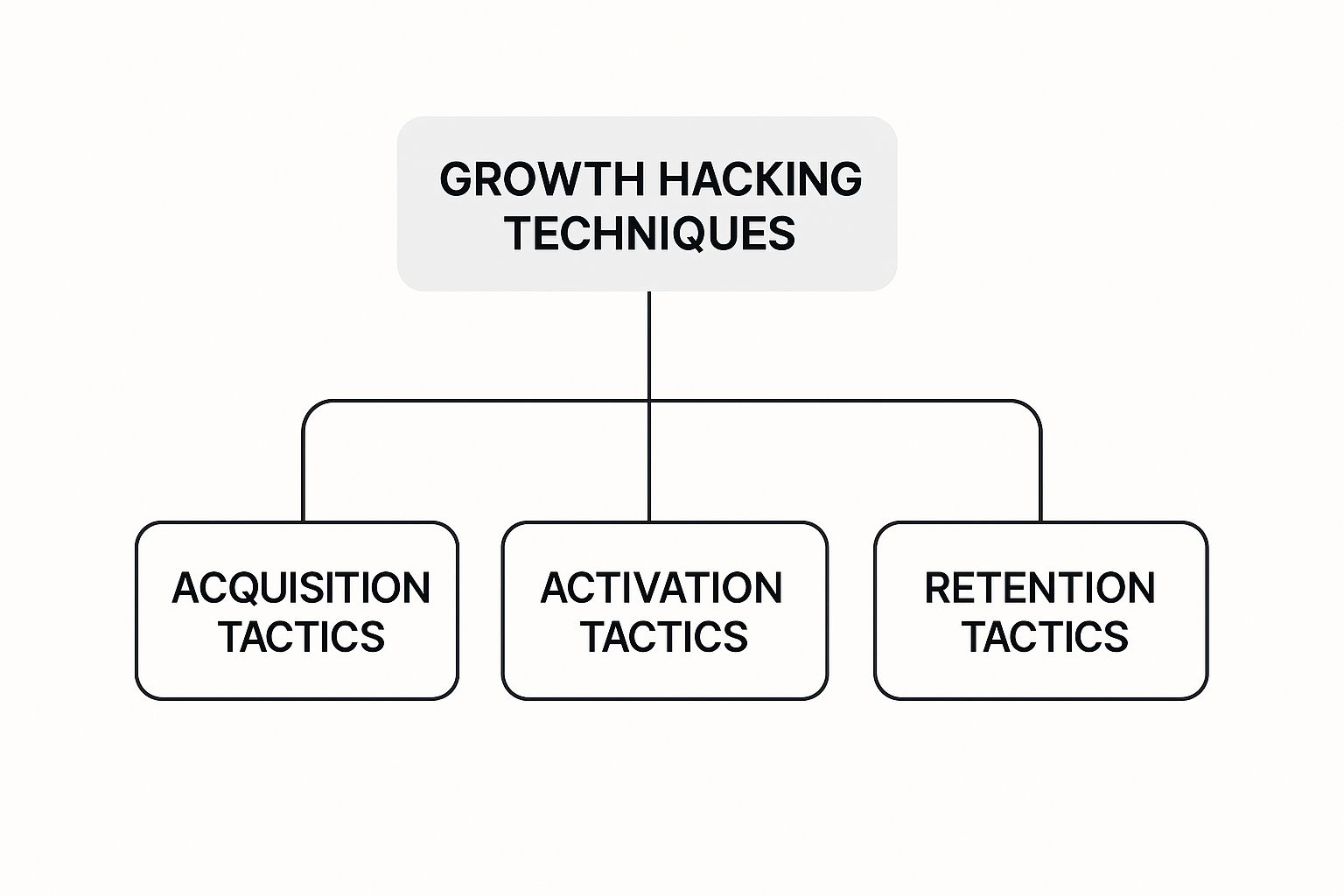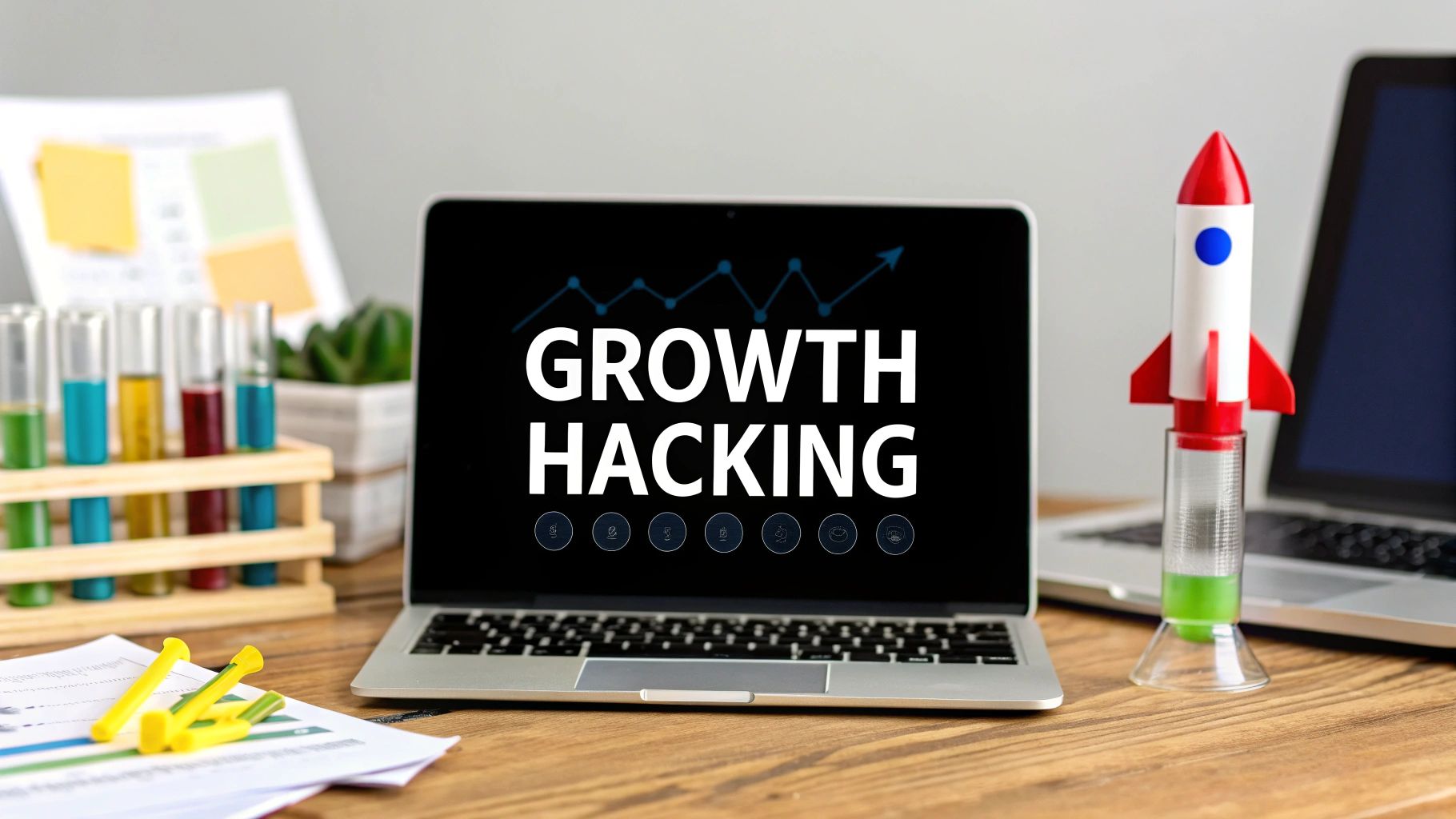What Is Growth Hacking? Boost Your Business Fast
Let's cut through the noise. When you hear the term growth hacking, don't think of it as just another marketing buzzword. At its heart, it's a mindset—a relentless, data-obsessed process of experimentation that touches every part of your business. It's not just about marketing; it's about finding the fastest, most efficient path to sustainable growth.
What Is Growth Hacking Really

Imagine your company is a high-stakes science lab. A traditional marketer might plan a big, expensive campaign and hope for the best. A growth hacker, on the other hand, acts like a scientist. They start with a hypothesis ("If we change the sign-up button color, we'll get more conversions"), run a small, cheap test to prove or disprove it, and then pore over the data.
This approach fundamentally changes the game. It shifts the focus away from broad, fuzzy goals like "brand awareness" and zooms in on specific, measurable outcomes. The question is always the same: "How can we get scalable growth as efficiently as possible?" This requires a special mix of creativity, sharp analytical thinking, and a bit of technical know-how.
Growth hacking is not about finding a single magic bullet; it's about building a repeatable system for growth. It’s a process of continuous improvement fueled by data and experimentation.
To really grasp what makes growth hacking different, it helps to see it side-by-side with a more traditional marketing approach.
Traditional Marketing vs Growth Hacking Mindset
| Aspect | Traditional Marketing | Growth Hacking |
|---|---|---|
| Primary Goal | Brand awareness, lead generation, sales | Sustainable, scalable user/customer growth |
| Process | Campaign-based, planned in advance | Iterative, continuous experimentation (test, measure, learn) |
| Focus | Top of the funnel (awareness, acquisition) | The entire customer funnel (AARRR) |
| Team Structure | Often siloed within the marketing department | Cross-functional (product, engineering, data, marketing) |
| Metrics | Vague metrics (impressions, reach, likes) | Hard data (conversion rates, LTV, virality, churn) |
| Budgeting | Large, upfront budget allocations | Small, agile budgets for rapid testing |
| Tools & Skills | Creative, communication, media buying | Data analysis, A/B testing, automation, coding basics |
The table makes it clear: this isn't just a new name for marketing. It's a completely different way of operating, built for speed and efficiency.
A Cross-Functional Discipline
This is where many companies stumble. Traditional marketing often stays in its lane. Growth hacking, by its very nature, can't. To be truly effective, it has to be a cross-functional discipline. A growth hacker is constantly working with:
- Product Teams: To build growth loops right into the product, like a seamless referral program or a viral sharing feature.
- Engineers: To quickly push out an A/B test on the website, tweak the user onboarding flow, or implement a new analytics tool.
- Data Analysts: To make sense of experiment results and spot the hidden opportunities that will inform the next test.
- Marketers: To ensure all messaging and channels are perfectly aligned with the experiments being conducted.
This integration is non-negotiable because growth opportunities are hiding everywhere. They could be in the first ad a person sees, the pricing model, the user onboarding sequence, or a simple email subject line. Every test, no matter how small, is a chance to learn something valuable.
Ultimately, growth hacking is a philosophy. It's about staying agile, being resourceful, and maintaining a laser focus on the one metric that truly matters: growth. By embracing this data-driven, experimental mindset, companies can learn faster, move quicker, and uncover innovative ways to scale that traditional methods would almost certainly miss.
The Story Behind Growth Hacking

Growth hacking didn't come out of a stuffy corporate boardroom or a university think tank. It was born in the trenches of Silicon Valley—forged by startups with shoestring budgets and an absolute need to grow faster and smarter than everyone else. The whole thing started with a simple, frustrating problem that sparked a new way of thinking.
Back in 2010, a marketer named Sean Ellis was helping startups scale, but he kept running into the same wall. He couldn't find the right person for the job. Traditional marketers were all about big campaigns and brand awareness, which was way too slow and expensive for a lean startup. He needed a different kind of expert, someone relentlessly focused on one thing: scalable growth.
So, Ellis came up with a new title to describe this role: the "growth hacker." For a growth hacker, the only metric that matters, their "true north," isn't brand sentiment or ad clicks. It's pure, measurable growth.
The Pioneers of Ingenuity
Even before the term "growth hacking" existed, the core principles were already in play. Early tech companies didn't have huge advertising budgets to throw around. They had to get creative and build growth right into the fabric of their products.
These early pioneers proved that a clever idea could be far more powerful than a fat checkbook. Their now-legendary tactics became the original playbook for what growth hacking could accomplish.
- Hotmail's Viral Signature: In one of the most brilliant early examples, Hotmail simply added a line at the bottom of every single email sent from their platform: "P.S. Get your free email at Hotmail." This tiny addition turned every user into a brand ambassador, creating a viral engine that pulled in millions of users for practically nothing.
- Dropbox's Referral Engine: When Dropbox entered a packed market, they knew they needed an edge. They launched a referral program that gave free storage space to both the person referring and the new user. This two-way incentive turned their entire user base into a powerful growth machine.
This product-led approach became a hallmark of the startup scene. Dropbox's referral program, for instance, boosted signups by a staggering 60%, bringing in 2.8 million users in just 15 months. It’s no surprise that by 2017, a survey found that 73% of startup marketers saw growth hacking as essential to their business. You can dive deeper into the origins of these kinds of tactics in this piece on the history of hacking from Kaspersky.
The lesson from these early wins is crystal clear: your product can often be your most powerful marketing channel.
A Mindset of Resourcefulness
The story of growth hacking really tells you everything you need to know about its DNA. It’s a discipline born out of necessity, one that values resourcefulness over resources. It's a mix of deep customer empathy, sharp data analysis, and a relentless cycle of experimentation to find the quickest, most efficient ways to grow.
This is where it ties directly into how modern businesses operate. You can't scale efficiently with just clever marketing; you also need rock-solid internal systems. Understanding https://makeautomation.co/what-is-marketing-operations/ is key, because it provides the structure needed to build the repeatable processes that fuel sustainable growth.
At its heart, the story of growth hacking is about ingenuity proving that the smartest idea—not the biggest budget—is what truly wins.
Using The AARRR Framework To Map Your Growth
If you really want to get a handle on growth hacking, you need a map for your customer's journey. The AARRR framework, which you'll often hear called "Pirate Metrics" (say it out loud: A-A-R-R-R), is that map. It’s way more than just a catchy name; it’s a brilliant model for figuring out what’s working in your business and, just as importantly, where you're losing customers.
Picture your business as a network of pipes. Potential customers flow in one end, and ideally, revenue flows out the other. The AARRR framework lets you check each joint in that system—Acquisition, Activation, Retention, Referral, and Revenue—so you can find the leaks and patch them up.
This approach breaks down the entire customer lifecycle into five clear, measurable stages. Each one answers a big question about how people interact with your product, giving you specific metrics to watch. By zeroing in on each stage, you can spot the bottlenecks holding you back and aim your growth experiments where they’ll make the biggest difference.
H3: Acquisition: How Do Users Find You?
It all starts here. Acquisition is about all the ways you get people to your front door—your website, your app, your landing page. This stage answers the most basic question of all: From where are our users coming?
But it’s not just about raw traffic numbers. It's about getting the right people to show up. Strong acquisition means your cost to acquire a customer (CAC) is a whole lot less than what they're worth to you over time (LTV).
Some of the most common ways to acquire users include:
- Content & SEO: Writing helpful articles, guides, or building free tools that pop up in search results and bring in organic traffic.
- Paid Ads: Running highly targeted campaigns on platforms like Google Ads or LinkedIn to get in front of very specific audiences.
- Social Media: Building a real community and sharing things that get people interested enough to click through.
- Public Relations: Getting mentioned in articles or podcasts to build credibility and introduce your brand to new crowds.
H3: Activation: Do Users Have A Great First Experience?
Getting someone to visit is only the first step. The next hurdle is Activation. This is where a visitor has that "aha!" moment—that first spark of understanding where they see the real value in what you offer. This stage answers the question: Are new users actually experiencing our product's core value?
A low activation rate is a huge red flag. It often points to a confusing onboarding flow or a gap between what your marketing promised and what the product actually delivers.
Activation isn't just someone signing up. It's the moment a user performs a key action that proves they "get it" and see how your product can help them.
For a project management tool, that moment might be creating their first to-do list. For an analytics platform, it could be installing the tracking code and seeing their first data point appear.
This visual helps show how growth hacking tactics are applied across the first few stages of this journey.

As you can see, growth hacking isn’t random. It’s a structured process with specific plays designed to guide users from just discovering you (Acquisition) to understanding your value (Activation) and, ultimately, deciding to stick around (Retention).
H3: Retention: Are Users Coming Back?
Acquiring customers costs money, sometimes a lot of it. Retention is where you build a sustainable business. This stage is all about keeping the customers you worked so hard to get. It answers a simple but critical question: Are our users engaged enough to return on their own?
Great retention is the clearest sign you've achieved product-market fit. It means your product has become an indispensable part of your users' workflow or life. Common tactics here involve smart email campaigns, helpful in-app notifications, and consistently shipping new features that your customers actually want.
H3: Referral: Do Users Tell Others?
The best marketing doesn't cost a dime—it's word-of-mouth. That's what the Referral stage is all about. It measures how many of your happy customers become brand evangelists. The key question here is: Do our users like our product enough to share it with their friends and colleagues?
This is where legendary growth hacks are born. Think about Dropbox’s famous referral program that gave both the sender and receiver extra storage space. A strong referral engine creates a viral loop, where every new user brings in even more new users, slashing your acquisition costs and putting growth on autopilot.
H3: Revenue: How Do You Make Money?
And finally, we get to Revenue. This is where all your hard work pays off, literally. This stage is laser-focused on turning active users into paying customers. It answers the ultimate business question: Are we successfully monetizing all this activity?
Here, you're tracking metrics like customer lifetime value (LTV), the conversion rate from a free trial to a paid plan, and average revenue per user (ARPU). When you optimize the four stages that come before it, the path to generating revenue becomes a whole lot smoother and more predictable.
To bring it all together, here’s a quick-reference table breaking down each stage of the AARRR framework.
AARRR Framework Breakdown
| Stage | What It Measures | Example Growth Tactics |
|---|---|---|
| Acquisition | Where new users are coming from. | SEO, paid ads, content marketing, social media campaigns |
| Activation | The "aha!" moment when users first find value. | Simple onboarding, interactive tutorials, welcome emails, checklists |
| Retention | How many users stick around over time. | In-app messaging, email newsletters, loyalty programs, new features |
| Referral | Whether users are recommending your product. | Two-sided referral programs, affiliate links, social sharing prompts |
| Revenue | The ability to turn users into paying customers. | A/B testing pricing pages, optimizing checkout flow, free-to-paid funnels |
By thinking about your growth strategy through this AARRR lens, you stop guessing and start making data-driven decisions that move the needle at every stage of the customer lifecycle.
Real-World Growth Hacking Examples

Theories and frameworks are great, but the true magic of growth hacking really clicks when you see it in the wild. The most legendary examples aren't about big budgets or complicated algorithms. They're about clever insights into human behavior and using existing platforms in ways no one else thought of.
These stories really get to the heart of the growth hacker mindset: finding the path of least resistance to the biggest possible impact. Let’s break down how a few iconic companies solved their early growth puzzles. Think of these not as old stories, but as timeless case studies in resourcefulness that show how to turn a product into its own marketing machine.
Airbnb Tapped into an Existing Ecosystem
When Airbnb first started, it was stuck in that classic "chicken-and-egg" situation. To get travelers, they needed properties. To get properties, they needed travelers. With zero brand recognition and a shoestring budget, they had to find their audience somewhere they already were. That place was Craigslist.
The team realized people looking for alternative places to stay were all over Craigslist. So, they did something brilliant—they built an unofficial integration that let Airbnb hosts cross-post their listings to Craigslist in a single click.
This simple but technically savvy solution was a total game-changer.
- Instant Audience Access: Without spending a cent on ads, Airbnb suddenly had its listings right in front of a massive, perfectly targeted audience.
- Perceived Value: The beautifully designed Airbnb listings popped against the plain, text-heavy posts on Craigslist, making them instantly more attractive.
- Viral Loop: As people on Craigslist clicked through to the superior Airbnb experience, many became new guests or even hosts, feeding both sides of their marketplace.
This wasn’t just a clever marketing stunt; it was a product-based solution that hijacked a huge existing network to solve a core business problem.
Dropbox Made Sharing the Product
Dropbox was launching into a crowded cloud storage market. Paying for ads was simply too expensive to work long-term. Their solution? They built growth right into the product with a two-sided referral program that has since become the gold standard for what is growth hacking.
The idea was simple but genius: invite a friend, and when they sign up, both of you get extra storage space for free. This was more than just a gimmick; it was a masterclass in psychology.
By rewarding both the referrer and the new user, Dropbox transformed a selfish act (getting more space for me) into a generous one (giving a gift to a friend).
This program turned their entire user base into a volunteer sales team. It kicked off a viral loop where every new user was motivated to bring in more users, leading to exponential growth. The results were incredible, proving that your product can be your most powerful acquisition channel.
HubSpot Offered Value Before the Sale
In the B2B and SaaS space, growth hacking often comes down to content and value. HubSpot, a giant in inbound marketing, nailed this by creating a free tool called Website Grader. Anyone could pop in their website URL and get an instant report card on their marketing and SEO performance, complete with actionable advice.
This tool was a lead-generation machine cleverly disguised as a helpful service.
- Massive Value Upfront: It gave potential customers real, personalized value without asking for anything in return.
- Identified Pain Points: The report showed people exactly where their website was falling short, creating an immediate need for a fix.
- Positioned HubSpot as the Solution: After pointing out the problems, HubSpot was perfectly positioned to offer its software as the cure.
The efficiency of these kinds of strategies is striking when you look at the numbers. Companies that embrace growth hacking have reported a customer acquisition cost (CAC) up to 50% lower than those using traditional marketing. One study found that tech startups using these methods had an average CAC of just $1.88 per user, compared to $3.24 for firms relying on conventional ads. This cost-effectiveness comes from using the product itself and data-driven experiments to scale quickly on a lean budget. You can find more insights on the history and impact of these kinds of innovative methods from Cybersecurity Ventures.
How to Build Your Own Growth Engine
Forget about finding one magical "growth hack" that will change your business overnight. That's a myth. Real, sustainable growth comes from building a system—a repeatable, data-driven engine that consistently uncovers and seizes new opportunities.
Think of it like a flywheel. At first, it's tough to get moving. But each successful experiment, each small win, adds momentum. Soon, the wheel is spinning faster and with less effort. This process is what turns growth from a guessing game into a predictable, scalable operation. You're building a culture that learns from everything, wins and losses alike, ensuring every action pushes you forward.
The Four Stages of the Growth Cycle
At the heart of any solid growth engine is a simple, four-step loop you run again and again. This cycle is the framework that turns raw ideas into real, measurable results.
- Ideate: This is where it all begins—the brainstorm. The goal is to generate a massive backlog of experiment ideas. Don't limit yourself. These ideas should come from everywhere: customer support tickets, feedback from sales calls, user behavior data, and even your competitors' latest moves. Your best insights often come from the people on the front lines.
- Prioritize: You can't possibly test every idea at once, so you need a way to rank them. This is critical for avoiding wasted time on experiments with little potential upside. A simple framework helps you focus your precious resources where they'll make the biggest difference.
- Test: Time to put your hypothesis to the test. Here, you design and run a small, controlled experiment to see if your idea has legs. The key is running clean tests with clear success metrics. You need to be able to trust the results, good or bad.
- Analyze: Once the test is done, you dive into the data. Did it move the needle? Why? Or just as importantly, why not? The insights you gather here are pure gold, especially from the failures. They feed right back into the ideation stage, making your next round of hypotheses that much smarter.
Prioritizing Your Experiments with the ICE Framework
Staring at a long list of ideas can be paralyzing. Where do you even start? The ICE score is a beautifully simple framework designed to cut through the noise and bring some objective logic to your decision-making. You just rate each idea on a scale of 1-10 for three key criteria.
- Impact: If this works, how big of an impact will it have on our most important metric?
- Confidence: How confident are we that this will actually succeed? (This should be based on data, past results, or solid user research, not just a gut feeling).
- Ease: How easy is this to implement? Think in terms of time, money, and engineering resources.
Multiply the three scores (Impact x Confidence x Ease) to get your final ICE score. The ideas with the highest scores get bumped to the top of the list. It’s a straightforward system that makes sure you're always working on experiments that have the best shot at delivering big results with reasonable effort. For instance, exploring programmatic SEO tactics can often generate high-impact ideas that are surprisingly low-effort to test.
A failed experiment is not a waste. It's a lesson learned that prevents you from making a bigger mistake later and provides data to fuel the next idea.
When you run this cycle consistently, you build more than just a playbook of tactics. You build a deep-rooted process of continuous learning and improvement. This engine is what separates the companies that get lucky once from those that achieve predictable growth by design. And as you get more advanced, you can start integrating some of the powerful AI-powered B2B growth strategies for 2025 right into this experimental loop.
Why Growth Hacking Matters More Than Ever
Not too long ago, "growth hacking" was a term whispered in the hallways of Silicon Valley startups. It felt like a niche, almost secret, way of thinking. Today, that’s all changed. Growth hacking has moved from the fringes to become a core part of how modern businesses operate.
Its core ideas—running fast experiments, letting data guide your decisions, and being relentlessly creative—aren't just nice-to-haves anymore. In a world where everyone is shouting for attention, they are survival skills. The old playbook of just buying more ads is broken. The game has changed, and growth hacking is the new rulebook.
A Mindset That's Gone Global
What started in tech hubs like San Francisco is now a worldwide phenomenon. You can trace the rise of growth hacking right alongside the explosion of digital startups and app stores across the globe. By 2023, it was pretty standard for startups in places like Berlin and Silicon Valley to have dedicated growth specialists—over 60% of them did.
This momentum didn't stop there. It quickly caught on in Asia-Pacific, where massive internet adoption and mobile-first cultures created the perfect environment for it to thrive. With over 750 million smartphone users in India alone, the region was ripe for strategies built on app virality and network effects. The results speak for themselves: startups using growth hacking in these areas saw user growth hit an average of 75% year-over-year, blowing past the 40% seen with traditional methods. Want to see how this kind of digital growth creates new challenges? Cobalt.io's analysis shows how digital growth and security challenges have evolved together.
This isn’t a fleeting trend. Growth hacking has become a fundamental operational mindset for any company that's serious about scaling in today's economy.
From Startup Playbook to Corporate Strategy
Perhaps the biggest sign of growth hacking's staying power is seeing huge, established corporations adopt it. These industry giants realized they were vulnerable to smaller, more agile competitors and started building their own internal "growth teams."
Their goal? To infuse their organizations with the speed and experimental spirit of a startup. They're now constantly testing everything—new product features, different pricing models, and untapped marketing channels—to stay competitive.
This shift by the big players cements the importance of understanding what is growth hacking. It’s a permanent move toward a more scientific, customer-focused way of building a business. Companies now know that winning means being ready to experiment, fail, learn, and pivot—fast. If you want to get into the nuts and bolts of tracking this work, our guide on how to measure business growth is a great place to start. As technology keeps evolving, this data-driven, iterative approach will only become more essential.
Common Questions About Growth Hacking
As growth hacking has moved from a Silicon Valley buzzword to a mainstream strategy, a few questions tend to pop up all the time. The core idea is simple enough, but the practical side of things can get a little fuzzy. Let's tackle some of the most common points of confusion to give you a clear, solid foundation.
Is Growth Hacking Just a Fancy New Name for Marketing?
Not at all, and the difference is fundamental. Think of traditional marketing as fishing with a giant net. You cast it wide, hoping to pull in a big, diverse catch. The focus is on broad-stroke activities like building brand awareness and generating leads across a wide audience.
Growth hacking, on the other hand, is more like spear fishing. It's precise, targeted, and intensely data-driven. A growth hacker isn’t just looking at the top of the funnel; they're obsessed with the entire customer journey, running experiments across product, engineering, and sales to find the most efficient ways to grow. It’s a completely different mindset.
Can a Non-Tech Company Really Use Growth Hacking?
Absolutely. While the term was born in the fast-paced world of tech startups, the principles are universal. Any business that wants to grow smarter, not just bigger, can adopt a growth mindset.
The secret sauce is experimentation and a relentless focus on data. An e-commerce store could run A/B tests on its product pages to see which layout converts better. A local restaurant could experiment with a new digital loyalty program to see if it drives more repeat customers. The specific tactics change, but the data-led, iterative process is exactly the same.
What Kind of Skills Does a Growth Hacker Actually Need?
The best growth hackers are often described as being “T-shaped.” This means they have a broad, working knowledge of many different areas (the horizontal bar of the T) but also have deep, specialized expertise in one or two key disciplines (the vertical stem).
The ideal growth hacker is a unique blend of creative marketer, data analyst, and product manager, all rolled into one.
Their skillset is a mixed bag, but a few core competencies are non-negotiable:
- Data Analysis: They have to be comfortable diving into analytics, spotting trends, and measuring the real impact of their experiments.
- Customer Psychology: Understanding why people click, buy, or churn is critical for developing hypotheses that actually work.
- Creativity: The ability to think beyond the standard marketing playbook to find untapped channels and unconventional solutions is what separates a good growth hacker from a great one.
- Technical Literacy: You don't need to be a senior developer, but you need to speak the language of tech well enough to collaborate effectively with engineers and product teams.
Once you demystify what is growth hacking, you realize it’s not about magic tricks or silver bullets. It's a disciplined, almost scientific, approach to building a business that can scale.
At MakeAutomation, we build the very systems that power this kind of growth. We help B2B and SaaS companies use AI and automation to streamline their operations, fire up their lead generation, and create a predictable engine for scaling. If you're tired of manual processes holding you back and are ready to unlock your company's true growth potential, you can learn more about our approach.







